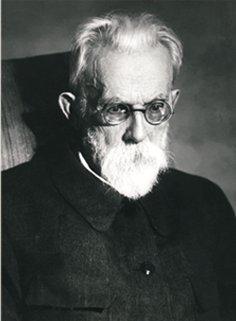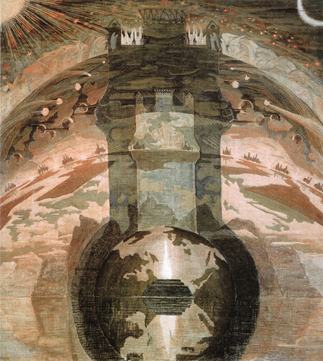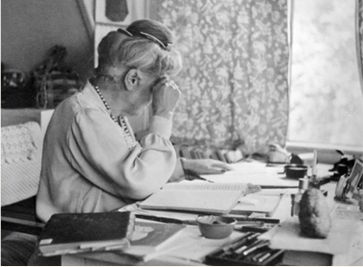V. Vernadsky also more than once resorted to the extra-scientific method of cognition to prove scientific points of the theory of noosphere. “Artistic creation reveals to us the cosmos passing through consciousness of a live creature,” this scientist of genius wrote.[4, p.235]
In studying very seriously the history of science and the scientific world outlook, Vernadsky as if sensed in himself the current of evolution leading to the creation of not only cosmic world perception, but also of a new system of cognition so much needed by the science that was rapidly developing at the beginning of the 20th century. This great Russian scientist was not only a unique specialist-naturalist, but a most interesting philosopher, as well, whose philosophic heritage was long negated in this country and is now just starting to be developed. Attitudes towards his studies on the part of philosophers and scientists today remain far from unambiguous. Vernadsky was one of the first to understand the discrepancy between the old system of cognition and the contemporary process of the development of science and to pose the problem of different views on the system of cognition in his philosophic studies. He as if removed the antagonism previously existing in the area of “science – non-science,” and granted equal rights to science and other methods of cognition, understanding quite well that if this were not done, it would reflect in a most fatal way primarily on science itself. “The scientific world outlook,” he wrote in 1902, “is developing in close communication and wide interaction with other aspects of the spiritual life of mankind. The separation of the scientific world outlook and science from the simultaneous or earlier activities of man in the spheres of religion, philosophy, public life, or art, is impossible. All these manifestations of human life are closely interwoven and can be only separated in one’s imagination.”[5, p.31] And more: “When studying the history of science, one can easily see for oneself that the sources of the most important aspects of the scientific world outlook appeared beyond the sphere of scientific thinking, penetrated it from the outside, just as the all-encompassing image of world harmony, striving for number, came into science from the outside. Thus, both the ordinary and the more particular, specific features of our scientific thinking, such as atoms, the impact of individual phenomena, matter, heredity, energy, ether, elements, inertia, the infinity of the world, etc., entered the [scientific – L. Sh.] world outlook from other realms of the human spirit; they were conceived and developed under the influence of ideas and understandings alien to scientific thought. [ . . . ] “But they appeared at the same time in other societies, rendering them forms closer to the designs of science – amongst religious sects, primarily magical and heretical, and amongst mystical philosophic teachings, which from ancient times had become accustomed to the admission of emanations, fluids, all kinds of bodyless influences into the surrounding world.”[6, p.29-31]
He believed, and quite justly, that it is impossible to separate in the contemporary scientific world outlook what came to it from “pure” empirical science and what came from non-science. And if this suddenly happened, contrary to any common sense, there would be only fragments left of the scientific world outlook. The scientific revolution of the 20th century itself composed an integral part of the Spiritual Revolution in which all its constituents were closely interwoven – the philosophy of the cosmic world perception, scientific achievements, findings of religious and gnostic thought, and the insights of poetry and art. In this active synthesis, from which, like Aphrodite from the sea foam, a new system of cognition was to appear, Vernadsky was most of all interested in the interaction of philosophy and science, or rather scientific thought. He considered philosophy as such, without dividing it into idealistic or materialistic, religious or atheistic, ancient or contemporary. He did not give preference to any of these systems, trying to reveal in them some common features that would make this interaction clearer. He did not raise the question, as modern philosophers do nowdays, of what is philosophy: science or non-science? He understood that philosophic thought goes far beyond the boundaries of science as such, being formed in an absolutely different space, that it is speculative, but, despite these kinds of “disadvantages,” it affects science, giving it the key for the comprehension of discovered phenomena. The role of philosophy grew especially in the period of the Spiritual Revolution, when it most closely came into contact with scientific thought. <...> The rapprochement of the scientific and extra-scientific methods of cognition is a true revolution, another essential step in the cognition of the Universe, without which the further development of both science and the new system of cognition would not be possible.
In the 1920-30s a whole series of books was published, in which various aspects of the problems of cosmic evolution were considered. The books had quite usual names: “The Call,” “Illumination,” “Community,” “Agni Yoga,” “Infinity,” “Hierarchy,” “The Heart,” “Aum,” “The Fiery World,” “Brotherhood.” The style of the texts was just as unusual, resembling a spiral along which the reader’s consciousness seemed to ascend. The books were prepared for printing and published by Nicholas and Helena Roerich and had a common name: The Living Ethics. They told about the cosmic evolution of mankind, its characteristics, the reasons for and role of man’s most complicated processes. The books produced a great impression already on the very first readers with their daring character and new approaches to problems, the solutions to which seemed once and forever achieved and canonized. Some people even believed that they were reading science-fiction books, which started appearing in great numbers on the world’s book market in those years. It was hard to believe that the Universe was a grandiose energetic system in which the intensive energetic and informational exchange among the structures of matter of various states and dimensions constituting it was taking place. Man himself was that kind of structure. The Living Ethics told about the Great Laws of the Cosmos, of which science did not yet know. And only a minority of people, or, rather, just some individuals, having gotten acquainted with the Living Ethics books, realized that they had before them the presentation of a new system of cognition, a cosmic world perception, and the Great Cosmic Laws mentioned by the Living Ethics’s anonymous Authors were making a gnoseological carcass of this amazing philosophy that reflected cosmic reality… <...>
|
| |||||||||||||||||
Copyright © 2008-2024 ST. PETERSBURG BRANCH OF THE INTERNATIONAL CENTER OF THE ROERICHS
Life and creative work of Nicholas Roerich | Exhibitions | Excursions | Scientific research | Protection of the Roerichs' name and heritage



